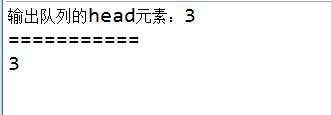标签:new 编写 不为 static poll ati lse test int
编写一个类,用两个栈实现队列,支持队列的基本操作(add、poll、peek)。
栈的特点是先进后出,而队列的特点是先进先出。我们用两个栈正好能把顺序反过来实现类似队列的操作。
具体实现上,是把一个栈作为压入栈,在压入数据时只往这个栈中压入,记为stackPush;另一个栈只作为弹出栈,在弹出数据时只从这个栈中弹出,记为stackPop。
因为数据压入栈的时候,顺序是先进先出的。那么只要把stackPush的数据再次压入stackPop中,顺序就变回来了。
将1-5依次压入stackPush,那么从stackPush的栈顶到栈底为5~1,此时依次再将5~1倒入stackPop,那么从stackPop的栈顶到栈底就变成了1~5.再从stackPop中弹出,顺序就和队列一样了。?
BUT,要做到以下两点:
(1)如果stackPush要往stackPop中压入数据,那么必须一次性把stackPush中的数据全部压入。
(2)如果stackPop不为空,stackPush绝对不能向stackPop中压入数据。
违反以上两点都会发生错误。
TwoStackQueue.java:
1 package cn.hl.p2; 2 3 import java.util.Stack; 4 /** 5 * 题目:由两个栈组成的队列 6 * 要求:用两个栈实现队列,支持队列的基本操作(add、poll、peek) 7 * @author 猩生柯北 8 * 9 */ 10 public class TwoStackQueue { 11 public Stack<Integer> stackPush; 12 public Stack<Integer> stackPop; 13 14 public TwoStackQueue(){ 15 stackPush = new Stack<Integer>(); 16 stackPop = new Stack<Integer>(); 17 } 18 19 public void add(int pushInt){ 20 stackPush.push(pushInt); 21 } 22 23 public int poll(){ 24 if(stackPop.empty() && stackPush.empty()){ 25 throw new RuntimeException("Queue is empty!"); 26 }else if(stackPop.empty()){ 27 while(!stackPush.empty()){ 28 stackPop.push(stackPush.pop()); 29 } 30 } 31 return stackPop.pop(); 32 } 33 34 public int peek(){ 35 if(stackPop.empty() && stackPush.empty()){ 36 throw new RuntimeException("Queue is empty!"); 37 }else if(stackPop.empty()){ 38 while(!stackPush.empty()){ 39 stackPop.push(stackPush.pop()); 40 } 41 } 42 return stackPop.peek(); 43 } 44 }
Test.java:
1 package cn.hl.p2; 2 3 public class Test { 4 public static void main(String[] args) { 5 TwoStackQueue tsq = new TwoStackQueue(); 6 tsq.add(3); 7 tsq.add(8); 8 tsq.add(-5); 9 tsq.add(0); 10 tsq.add(8); 11 System.out.print("输出队列的head元素:"); 12 System.out.println(tsq.peek()); 13 System.out.println("==========="); 14 System.out.println(tsq.poll()); 15 } 16 17 }

标签:new 编写 不为 static poll ati lse test int
原文地址:https://www.cnblogs.com/zhzcode/p/9574362.html